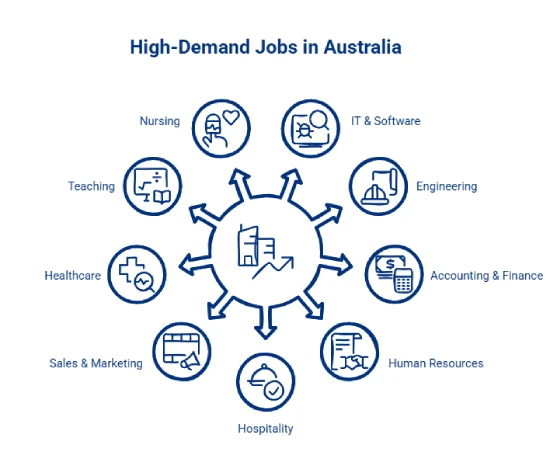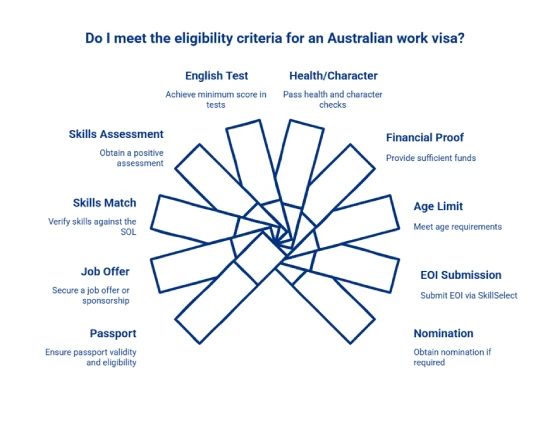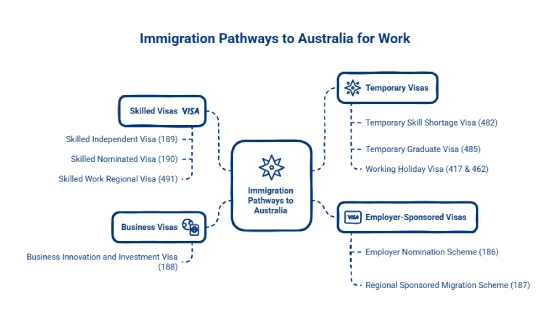Australia's strong economy and immigration system that focuses on skills are opening doors for workers from abroad. There's lots of demand in fields like healthcare, construction, engineering, and IT. Skilled workers are needed to fill gaps and help the country grow.
| Occupation | Annual salary in AUD |
| IT | $81,000 – $149,023 |
| Marketing & Sales | $70,879 – $165,000 |
| Engineering | $87,392 – $180,000 |
| Hospitality | $58,500 – $114,356 |
| Healthcare | $73,219 – $160,000 |
| Accounting & Finance | $89,295 – $162,651 |
| Human Resources | $82,559 – $130,925 |
| Teaching | $75,284 – $160,000 |
| Professional and Scientific Services | $90,569 – $108,544 |
Australia is a great place to live, with good salaries and solid worker rights, making it a popular choice for skilled migrants. Right now, there are over 400,000 job openings across the country, especially in healthcare, IT, and construction.

A work permit for Australia lets foreign workers live and work there legally for a set time. These permits come under different visa types depending on things like skills, job offers, and sponsorship. Some common ones are the Temporary Skill Shortage (TSS) visa, the Skilled Independent visa, and the Employer Nomination Scheme. Getting a work permit is the primary step for skilled workers who want to find a job and possibly settle down in Australia for good.
*Want to apply for an Australia work visa? Let Y-Axis assist you with the process.
Australia has different work visas aimed at attracting skilled workers, entrepreneurs, and temporary staff to fill job gaps. Each visa fits various job needs, lengths of stay, and eligibility rules.
Here are the main types of Australia Work Visas:
Note: Each visa has specific eligibility requirements, including skill checks, language skills, job offers, and sponsorship details.
Australia has plenty of job options that pay well across different fields. Whether you're coming from abroad or just finishing your studies, the job market here offers solid chances for career growth.
Here’s a look at some of the top-paying jobs in Australia along with average salaries and insights.
The tech scene in Australia is booming, with jobs in software development, cybersecurity, data analytics, and IT project management.
Average Salary: AUD 100,000/year
Salary Range: AUD 80,000 to AUD 140,000/year
Engineers are needed in civil, electrical, mechanical, and mining sectors, particularly in areas focused on construction and infrastructure.
Average Salary: AUD 105,000/year
Salary Range: AUD 70,000 to AUD 150,000/year
Roles like accountants, financial planners, and analysts are essential for businesses and typically come with good pay.
Average Salary: AUD 90,000/year
Salary Range: AUD 65,000 to AUD 150,000/year
HR professionals are vital for planning the workforce, ensuring compliance, and recruitment processes within companies.
Average Salary: AUD 95,000/year
Salary Range: AUD 75,000 to AUD 140,000/year
With tourism picking up, positions for chefs, hotel managers, and hospitality supervisors are on the rise.
Average Salary: AUD 60,000/year
Salary Range: AUD 45,000 to AUD 90,000/year
There is a growing need for experts in digital marketing, brand strategy, and B2B sales, often with good pay.
Average Salary: AUD 85,000/year
Salary Range: AUD 55,000 to AUD 140,000/year
Healthcare workers, including doctors and allied health professionals, are highly sought after.
Average Salary: AUD 100,000/year
Salary Range: AUD 70,000 to AUD 180,000/year
Teachers, especially in STEM and special education, are in demand in primary and secondary schools across the country.
Average Salary: AUD 85,000/year
Salary Range: AUD 65,000 to AUD 115,000/year
There’s a significant shortage of nurses in Australia, which opens up great job opportunities in hospitals and aged care.
Average Salary: AUD 75,000/year
Salary Range: AUD 60,000 to AUD 110,000/year

*Want to work in Australia? Sign up with Y-Axis to guide you with the process.
If you want to live and work in Australia, you need to meet some specific criteria set by the Department of Home Affairs.
The list of general eligibility criteria for a work visa in Australia is as follows:

You must fulfill the requirements below to apply for an Australian work visa:
Australia offers different options for skilled migration to bring in workers from around the world to fill job gaps.
Here are some of the immigration pathways through which you can move to Australia:

*Want to migrate to Australia? Let Y-Axis assist you with the process.
You can follow the steps below to apply for jobs in Australia:
Step 1: Check if your job is on Australia's Skilled Occupation List.
Step 2: Create a resume and cover letter that fit Australian standards.
Step 3: Start applying for jobs on sites like SEEK, Indeed, or LinkedIn.
Step 4: Have your qualifications assessed if needed.
Step 5: Go to interviews with potential employers.
Step 6: Get a formal job offer.
Step 7: Apply for the right work visa for Australia.
Y-Axis is the world's No.1 overseas Immigration consultant, providing unbiased and innovative immigration assistance for 25+ years.
Our team of experts will assist you with:
Australia is currently facing skill shortages in many fields, with a high need for both professional and trade jobs. According to the latest Occupation Shortage List (OSL), these roles are a priority:
Note: These jobs are part of Australia’s Medium and Long-term Strategic Skills List (MLTSSL) and are a key focus in regional and national migration programs.
Here is a breakdown of the requirements you need to get a work permit in Australia, whether it’s temporary or permanent:
Some of most in-demand jobs in Australia are as follows:
Step 1: Find your occupation on the Skilled Occupation List.
Step 2: Get your resume in Australian style.
Step 3: Apply on sites like SEEK, LinkedIn, or directly on company websites.
Step 4: If needed, get a skills assessment.
Step 5: Go to interviews and try to get a job offer.
Step 6: Apply for the right work visa for Australia.
The different types of Australian work visas ae as follows:
Eligibility depends on the visa type, with general criteria including:
Step 1: Pick the right visa subclass.
Step 2: Gather your documents: passport, proof of skills, English test scores, and any nominations.
Step 3: Submit everything online through ImmiAccount.
Step 4: Pay the visa fees and go to any health and biometric appointments.
Step 5: Wait for processing and approval.
The national average for full-time jobs is about AUD 89,100 to AUD 93,000 a year.
Some of the non-skilled roles that are in-demand in Australia are as follows:
Note: These jobs often come with seasonal and working holiday visas, especially in rural areas.
Well, it really depends on where you are and how you like to live. Cities like Sydney and Melbourne are usually pricier than smaller towns. Your biggest expenses will likely be rent, getting around, groceries, and healthcare.
| Expense Category | Estimated Monthly Cost |
| Rent (1-bedroom apartment) | $1,200 – $2,200 |
| Utilities (electricity, water, internet) | $200 – $350 |
| Groceries & Food | $400 – $800 |
| Public Transport | $120 – $200 |
| Health Insurance (if applicable) | $100 – $150 |
| Miscellaneous (leisure, clothing, etc.) | $200 – $400 |
| Total Estimated Cost | $2,200 – $4,100 |